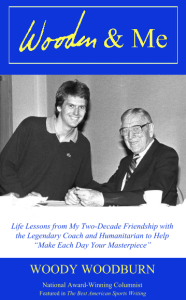 Woody’s highly anticipated new book “STRAWBERRIES IN WINTERTIME: Essays on Life, Love, and Laughter” is NOW available! Order your signed copy HERE!
Woody’s highly anticipated new book “STRAWBERRIES IN WINTERTIME: Essays on Life, Love, and Laughter” is NOW available! Order your signed copy HERE!
* * *
Family Roots: Soil, Seed and Corn
This Tuesday past was National Agriculture Day, a day I observed by enjoying some fresh guacamole made from local-grown avocados and earlier giving thanks to those doing backbreaking work in a strawberry field as I drove past.
As John Greenleaf Whittier wrote: “Give fools their gold, and knaves their power; let fortune’s bubbles rise and fall; who sows a field, or trains a flower, or plants a tree, is more than all.”
And, the poet should have added, he and she who harvest a field.
My farming roots run five generations deep into the rich soil of Ohio.
My paternal great grandfather, J.D., in particular, was renowned in the agricultural community. His 330-acre farm on Route 68, south of the small town of Urbana, was saturated with nutrients from long-ago floodings of the Mad River. On this fertile land, over many years, he developed what respectfully became know far and wide simply as “Woodburn Corn.”
J.D. began with a variety of dark corn called “Ripley” that his grandfather began growing on the family farm 70 years earlier as animal feed. J.D. cross-pollinated Ripley with a light-colored variety called “Loudenbark.” The result was what you would expect: ears of corn with a mix of both light and dark kernels.
For several successive years, J.D. selected the darker of these new ears to use as seed to repeat the process, believing this would result in a more robust and bountiful variety.
A few years into his experimentation, J.D. tested his hypothesis by planting his hybrid seed in a side-by-side test. Specifically, he sowed seven acres with the darker selection he favored and seven acres with the lighter kernels he was trying to eliminate. To his surprise, the lighter corn out-yielded the dark – and greatly so.
Thereon, J.D. switched his focus to developing an improved variety of light-colored corn. Importantly, he also selected the ears with the largest kernels – the result being corn with more animal feed per ear. He ultimately would spend more than four decades improving his corn.
About 10 years into the process, a grain elevator worker noticed that J.D.’s corn was far superior to the other corn coming in. The worker started recommending it to others, and soon J.D. was selling all his extra seed to neighbor farmers – and much further away, too.
And for good reason: J.D.’s “Woodburn Corn” won the gold medal for the Utility Contest at the Ohio State Fair as well as the silver medal for Yield. With a test result of 98-percent germination, J.D.’s entry crop in the ten-acre contest resulted in 112.64 bushels of corn per acre.
“Topping one-hundred bushels per acre was like breaking the four-minute mile,” my dad recalls, adding of his trips as a young boy to the State Fair: “Farmers from all over would come up to ask Grandpa for advice.”
Interestingly, and remarkably, J.D. grew the prize bounty without using any manure or fertilizer. Rather, he simply grew it in a virgin pasture – that is how fertile his farmland was. “One of the choicest farms of his township,” according to The History of Champagne County, Ohio.
However, it took more than choice magical land to grow medal-winning crops.
“Good seed, that’s the one big secret of our crop,” J.D. told a newspaper reporter. “But I don’t know as you would call it a secret. It’s a thing any good farmer knows.”
While my great-grandfather won prizes for his corn, my great uncle – “Unc” – earned his own measure of local fame in Urbana for his green thumb.
Instead of using wooden stakes for his garden beans to climb, Unc got the idea to plant a single sunflower seed inside each circle of planted bean seeds – the beans, he reasoned, would then be able to climb the rising sunflower stock.
Well, as they say, the best laid plans . . .
The beans withered and died because the sunflowers bogarted the extra fertilizer and water intended for the beans. Not all was lost, however, as Unc boasted – and was teased for – “the tallest crop of sunflowers in town.”
* * *
Woody Woodburn writes a weekly column for The Ventura County Star and can be contacted at WoodyWriter@gmail.com.
 Check out my new memoir WOODEN & ME: Life Lessons from My Two-Decade Friendship with the Legendary Coach and Humanitarian to Help “Make Each Day Your Masterpiece”
Check out my new memoir WOODEN & ME: Life Lessons from My Two-Decade Friendship with the Legendary Coach and Humanitarian to Help “Make Each Day Your Masterpiece”
- Personalized signed copies are available at WoodyWoodburn.com
- Unsigned paperbacks or Kindle ebook can be purchased here at Amazon
